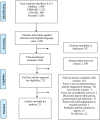Child/youth, family and public engagement in paediatric services in high-income countries: A systematic scoping review
- PMID: 31981295
- PMCID: PMC7104655
- DOI: 10.1111/hex.13017
Child/youth, family and public engagement in paediatric services in high-income countries: A systematic scoping review
Abstract
Background: Patient and public engagement in paediatric health-care decision making is under-researched, and there is a lack of systematically reviewed literature in this area.
Objective: To examine the extent, range and nature of published research investigating the engagement of children/youth, families and the public in paediatric service improvement, to summarize key aspects of the research identified and to identify gaps to help inform future research needs.
Methods: Literature was sought in MEDLINE, EMBASE, PsycINFO and CINAHL. Eligible articles presented research focused on patient, family and public engagement strategies in the paediatric health-care setting. Two reviewers extracted and charted data and analysed findings using a descriptive numerical summary analysis and a thematic analysis.
Results: From 4331 articles, 21 were eligible. Most were from the United States. The majority of studies were undertaken in hospital settings and used quantitative methods. Various patient and public engagement strategies/interventions were examined, including shared decision-making tools, questionnaires, youth councils/family advisory groups, patient portals and online networks. Most of the studies examined child/youth/parent satisfaction, with fewer investigating treatment outcomes or service improvement. The majority of studies investigated an engagement strategy at the 'individual treatment' level of engagement. Regarding the continuum of engagement, most of the studies were at either the 'consultation' or 'involvement' stage.
Conclusion: Future research needs to focus on the investigation of engagement strategies delivered in primary care, and the use of more qualitative and mixed methods approaches is recommended. There is a gap in the area of engagement strategies directed towards 'service design and resources' and 'macro/policy' levels.
Keywords: child health; literature review; paediatric services; patient and public engagement; scoping review.
© 2019 The Authors Health Expectations published by John Wiley & Sons Ltd.
Conflict of interest statement
None of the authors declared any conflicts of interest.
Figures
References
-
- Sarrami Foroushani P, Travaglia J, Eikli M, Braithwaite J Consumer and community engagement: a review of the literature. 2012. https://www.aci.health.nsw.gov.au/__data/assets/pdf_file/0010/165592/Con....Accessed November 19, 2019.
-
- Mockford C, Staniszewska S, Griffiths F, Herron‐Marx S. The impact of patient and public involvement on UK NHS health care: a systematic review. Int J Qual Health Care. 2012;24(1):28‐38. - PubMed
-
- Barello S, Graffigna G, Vegni E, Bosio AC. The challenges of conceptualizing patient engagement in health care: a lexicographic literature review. J Participatory Med. 2014;6(11):259‐267.
-
- Health Committee . Patient and Public Involvement in the NHS: Third Report of Session 2006–07. 2007. https://publications.parliament.uk/pa/cm200607/cmselect/cmhealth/278/278....Accessed November 19, 2019.
Publication types
MeSH terms
LinkOut - more resources
Full Text Sources
Medical
Miscellaneous


